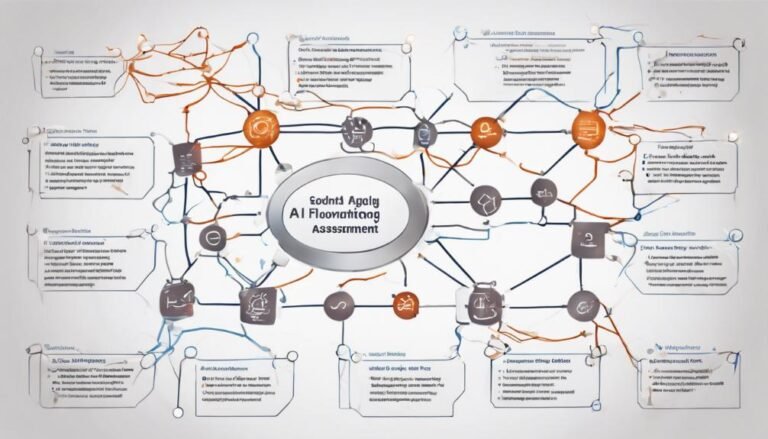AI in Asset Management
In asset management, AI technology plays a pivotal role in optimizing investment strategies and delivering actionable insights to investors. Imagine having the ability to predict market trends, mitigate risks, and make informed decisions swiftly. AI's power lies in its capacity to streamline processes and enhance portfolio performance. The integration of AI algorithms in asset management opens up a domain of possibilities for investors seeking to stay ahead in an ever-evolving financial landscape.
Key Takeaways
- AI enhances performance evaluation of investment portfolios.
- AI swiftly processes vast market data for pattern identification.
- AI contributes to cost efficiency through automation.
- AI aids in risk assessment and trade execution efficiency.
- AI utilizes advanced algorithms for market trend prediction.
AI Applications in Asset Management
AI plays a pivotal role in asset management by utilizing advanced algorithms to analyze market data and optimize investment strategies. When it comes to performance evaluation, AI excels in providing accurate and timely assessments of investment portfolios. By swiftly processing vast amounts of data, AI can identify patterns, trends, and potential risks, enabling asset managers to make informed decisions that enhance portfolio performance.
Moreover, AI applications contribute greatly to cost efficiency in asset management. Through automation and predictive analytics, AI streamlines processes, reduces human error, and minimizes operational costs. By implementing AI-powered tools for tasks such as risk assessment and trade execution, asset managers can cut down on unnecessary expenses while improving overall efficiency.
Data Analysis and Insights
Effective data analysis in asset management is essential for deriving valuable insights that drive informed decision-making and optimize investment strategies. Utilizing predictive analytics allows asset managers to forecast future market trends and potential investment outcomes based on historical data.
Performance evaluation is pivotal in evaluating the effectiveness of investment decisions and the overall portfolio performance. Trend analysis helps identify patterns and market movements, guiding asset managers in making proactive adjustments to their strategies.
Data visualization plays an important role in presenting complex data in a clear and concise manner, enabling asset managers to quickly identify trends, correlations, and outliers. By visualizing data through charts, graphs, and dashboards, asset managers can gain a deeper understanding of market dynamics and performance metrics. This visual representation enhances decision-making processes by providing a detailed overview of the investment landscape.
Incorporating advanced data analysis techniques empowers asset managers to make data-driven decisions, optimize portfolio performance, and stay ahead of market trends. Embracing these analytical tools is key to revealing valuable insights and gaining a competitive edge in asset management.
Risk Mitigation Strategies
You can leverage machine learning algorithms to enhance risk mitigation strategies in asset management by analyzing vast amounts of data efficiently.
These techniques can provide valuable insights into potential risks, helping you make more informed decisions to protect your investments.
Machine Learning for Risk
Utilizing machine learning algorithms can enhance risk mitigation strategies in asset management by providing predictive insights based on historical data patterns. Machine learning models are adept at identifying complex relationships within vast datasets, enabling more accurate risk prediction.
By analyzing past market behaviors and correlating them with specific risk factors, these algorithms can forecast potential risks with greater precision than traditional methods.
One key advantage of machine learning for risk is its ability to adapt and learn from new data in real-time, allowing for dynamic risk assessments that evolve alongside market conditions. This adaptability enhances the proactive nature of risk management strategies, enabling quicker responses to emerging threats.
Additionally, machine learning algorithms can automate the process of risk identification and assessment, saving time and resources while improving accuracy.
Data Analysis Techniques
Data analysis techniques play a pivotal role in developing robust risk mitigation strategies within asset management practices.
Quantitative analysis forms the foundation for evaluating and managing risks effectively. By utilizing historical data and mathematical models, asset managers can quantify various risk factors and make informed decisions based on statistical evidence.
Predictive modeling further enhances risk mitigation efforts by forecasting potential outcomes and identifying areas of concern before they materialize. Through the application of advanced algorithms, asset managers can identify patterns, trends, and correlations within vast datasets, allowing for proactive risk management strategies.
Incorporating data analysis techniques not only helps in identifying potential risks but also aids in optimizing investment portfolios and enhancing overall performance. By leveraging quantitative analysis and predictive modeling, asset managers can gain a deeper understanding of market dynamics and make data-driven decisions that align with their risk tolerance and investment objectives.
Ultimately, integrating sophisticated data analysis techniques into asset management practices empowers professionals to navigate complex financial landscapes with confidence and precision.
Portfolio Optimization Techniques
You should consider the various risk assessment models and machine learning applications that are fundamental in portfolio optimization techniques.
These models and applications play an essential role in helping you analyze and manage risks while maximizing returns.
Risk Assessment Models
Effective portfolio optimization techniques are essential for implementing robust risk evaluation models in asset management using AI. By harnessing predictive analytics and understanding market volatility, asset managers can utilize machine learning algorithms to enhance their asset allocation strategies.
Predictive analytics play a vital role in evaluating potential risks by analyzing historical data trends and predicting future market behavior. This allows for a more informed decision-making process when constructing investment portfolios.
Market volatility can greatly impact investment performance, making it essential for risk evaluation models to account for these fluctuations. Through advanced portfolio optimization techniques, such as mean-variance analysis and Monte Carlo simulations, asset managers can optimize their portfolios to achieve a balance between risk and return.
Machine learning algorithms can further improve risk evaluation models by identifying patterns in data that human analysts may overlook, leading to more accurate risk evaluations.
Incorporating these innovative approaches into risk evaluation models can provide asset managers with a competitive edge in navigating intricate financial markets and achieving superior investment outcomes.
Machine Learning Applications
Utilizing machine learning algorithms for portfolio optimization techniques enhances asset managers' ability to achieve the best risk-return balances in asset management. Predictive analytics play an essential role in forecasting asset movements, enabling managers to make informed decisions based on historical data patterns.
By analyzing past market trends and identifying key indicators, machine learning models can predict potential future outcomes with a high degree of accuracy.
Anomaly detection is another valuable application of machine learning in asset management. These algorithms can flag unusual behavior or outliers in financial data, alerting managers to potential risks or opportunities that may have gone unnoticed through traditional methods.
By swiftly identifying irregularities, asset managers can take proactive measures to mitigate risks and optimize portfolio performance.
Sentiment analysis is also a powerful tool that leverages machine learning to gauge market sentiment and investor emotions. By analyzing news articles, social media posts, and other textual data, these algorithms can provide insights into market trends and investor behavior, helping asset managers make more informed decisions.
Combined, these machine learning applications offer asset managers a complete set of tools to optimize portfolios and navigate the complexities of the financial markets effectively.
Market Trends Prediction
Predicting market trends accurately is an essential aspect of asset management, and the integration of artificial intelligence has revolutionized this process. AI algorithms have enhanced stock price forecasting through advanced predictive analytics, enabling asset managers to make informed decisions based on data-driven insights.
These algorithms analyze historical price data, trading volumes, and market trends to forecast potential price movements with greater accuracy than traditional methods.
Moreover, AI plays a vital role in market volatility predictions and trend analysis. By utilizing machine learning models, asset managers can identify patterns in market behavior and anticipate shifts in volatility.
This proactive approach allows for better risk management and the ability to capitalize on emerging opportunities in dynamic market environments.
Investment Decision-making
Enhancing asset management strategies, artificial intelligence optimizes investment decision-making through data-driven insights and advanced analytics. AI algorithms play a pivotal role in analyzing vast amounts of financial data to identify patterns and trends that human analysis may overlook.
This ability is especially valuable in behavioral finance analysis, where AI can detect investor behavior patterns and market anomalies that influence decision-making.
Sentiment analysis is another key aspect where AI excels, allowing asset managers to gauge market sentiment accurately. By processing news articles, social media feeds, and other sources, AI can assess public perception and predict market reactions more effectively.
Moreover, AI algorithms can swiftly adapt to changing market conditions, providing real-time insights for making informed investment decisions. This agility in processing and interpreting data enables asset managers to react promptly to market shifts and optimize their investment strategies accordingly.
Benefits for Investors
Artificial intelligence in asset management offers significant advantages for investors by providing robust data analysis and real-time insights. Through AI-driven tools, investors can enhance their engagement by gaining access to personalized investment recommendations and tailored insights. These platforms enable seamless performance tracking, allowing investors to monitor their portfolios with precision and make informed decisions promptly.
Moreover, AI empowers investors to develop and execute long-term strategies with confidence. By leveraging advanced algorithms and machine learning capabilities, investors can analyze market trends, identify potential opportunities, and mitigate risks effectively. This proactive approach not only improves decision-making but also enhances overall profitability analysis.
In essence, AI serves as a valuable ally for investors, offering them a competitive edge in the dynamic world of asset management. By embracing AI-powered solutions, investors can navigate complexities with ease, optimize their investment strategies, and ultimately achieve their financial goals with precision and foresight.
Conclusion
To sum up, AI in asset management offers a sophisticated toolset for investors seeking to navigate the complexities of the financial markets. By harnessing advanced algorithms and predictive analytics, AI provides a strategic edge in optimizing portfolio performance and minimizing risks.
Embracing this innovative technology is akin to having a skilled navigator guiding you through the turbulent waters of investment, ultimately steering you towards a prosperous financial future.







